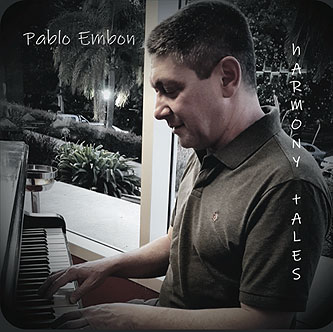 The
music of Israel-based multi-instrumentalist Pablo Embon is
a great way to take a break from the pressure and tension in the world
today. As several writers have already noted, Pablo has released upwards
of 20 solo albums of his unique instrumental music and his 2020 album
is called Harmony Tales. The prolific nature
of Pablo and his music aside, the 12-track Harmony Tales is
possibly the crowning achievement in his growing catalog of music
releases. The beauty of Pablo’s music centers upon his unique
compositional style of writing and arranging as well as his mastery
of most keyboards and guitar styles and sounds—from straight
ahead jazz to fusion and even rock. Being all instrumental and totally
original in nature, Pablo’s music allows the listener’s
imagination to run wild. The fact that Pablo was born in Argentina,
and that he has been based in Israel for the past 30 years, is not
so important to the listener, as Harmony Tales is a world-class
album of international instrumental jazz-fusion music at its finest.
Some writers have already noted that Harmony Tales is a superb
showcase for Pablo’s piano and keyboards skills overall, but
the 12-track, 54-minute album is also a fine showing of his guitar
skills, as there’s plenty of his fretboard work here too. Drawing
from a wealth of inspiring musical styles, Harmony Tales is
brimming with creative songs and solid arrangements that easily dip
into the wide world of diverse sounding genres—moving from jazz
and funk to Latin sounds and fusion as well. Track after glorious
track, Harmony Tales is just that—a totally relaxing album
of easy-on-the-ears instrumental music from the all-inclusive musical
mind of the multitalented Pablo Embon. In an age of global stress
and anxiety, you won’t find a more upbeat sonic elixir than the
2020 CD release of Harmony Tales by guitar / piano maestro
Pablo Embon. www.soundcloud.com
/ www.reverbnation.com
/ www.facebook.com
/ www.twitter.com
/ www.youtube.com
/ www.pablo-embon.com
The
music of Israel-based multi-instrumentalist Pablo Embon is
a great way to take a break from the pressure and tension in the world
today. As several writers have already noted, Pablo has released upwards
of 20 solo albums of his unique instrumental music and his 2020 album
is called Harmony Tales. The prolific nature
of Pablo and his music aside, the 12-track Harmony Tales is
possibly the crowning achievement in his growing catalog of music
releases. The beauty of Pablo’s music centers upon his unique
compositional style of writing and arranging as well as his mastery
of most keyboards and guitar styles and sounds—from straight
ahead jazz to fusion and even rock. Being all instrumental and totally
original in nature, Pablo’s music allows the listener’s
imagination to run wild. The fact that Pablo was born in Argentina,
and that he has been based in Israel for the past 30 years, is not
so important to the listener, as Harmony Tales is a world-class
album of international instrumental jazz-fusion music at its finest.
Some writers have already noted that Harmony Tales is a superb
showcase for Pablo’s piano and keyboards skills overall, but
the 12-track, 54-minute album is also a fine showing of his guitar
skills, as there’s plenty of his fretboard work here too. Drawing
from a wealth of inspiring musical styles, Harmony Tales is
brimming with creative songs and solid arrangements that easily dip
into the wide world of diverse sounding genres—moving from jazz
and funk to Latin sounds and fusion as well. Track after glorious
track, Harmony Tales is just that—a totally relaxing album
of easy-on-the-ears instrumental music from the all-inclusive musical
mind of the multitalented Pablo Embon. In an age of global stress
and anxiety, you won’t find a more upbeat sonic elixir than the
2020 CD release of Harmony Tales by guitar / piano maestro
Pablo Embon. www.soundcloud.com
/ www.reverbnation.com
/ www.facebook.com
/ www.twitter.com
/ www.youtube.com
/ www.pablo-embon.com
mwe3.com presents an interview with
Pablo Embon
The Harmony Tales interview
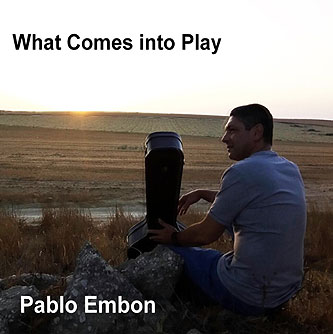 mwe3:
I was listening to the lead off track, “Vintage Lover”,
on your new album Harmony Tales and I was thinking that your
music has a nice calming effect. Have other people told you about
the relaxing nature of your music?
mwe3:
I was listening to the lead off track, “Vintage Lover”,
on your new album Harmony Tales and I was thinking that your
music has a nice calming effect. Have other people told you about
the relaxing nature of your music?
Pablo Embon: The relaxing nature of my music derives typically
from a state of mind. Music has a therapeutic effect on people and
sometimes composing that type of music helps myself to some extent
as well.
mwe3: Would you say there’s more of a keyboard-based vibe
on Harmony Tales, say compared with your 2019 Reminiscent
Moods album? How many keyboards are featured on the lead off track
“Vintage Lover”? I hear a Rhodes type keyboard, yet there’s
also some great guitar on that track too.
Pablo Embon: I am guilty as charged. “Vintage Lover”
is quite a multilayered arranged song... including a concert Yamaha
grand piano blended with the amazing Yamaha CP-80 electric piano,
one of my favorites, heard on the chorus and several multi-timbral
synth leads and pads. The main differences between the keyboards used
on Reminiscent Moods and Harmony Tales is that this
time I started experimenting with blending different sounds to create
new sounds. There is practically no limits for this and I found myself
fascinated when a new layered sound comes up and takes the song to
a totally different place.
mwe3: What’s your take on the compositional differences
and any different recording approaches between Harmony Tales and
the 2019 Reminiscent Moods album and is there a story behind
the title of the new album?
Pablo Embon: The Harmony Tales compositions flow more
naturally, in my mind, but without losing the end message of the song.
Also, for the most part, the songs / concepts have been initiated
on piano work and then arranged with guitars and other instruments.
The piano is my basic core instrument for composition. Most harmonies
and arrangements come from performing on this instrument, probably
leading to the title of the album.
 mwe3:
When was “Calling Out” written and recorded? It’s very
much a keyboard type track but then the electric lead guitar solo
takes over. The guitar sounds on that track are very vintage sounding.
mwe3:
When was “Calling Out” written and recorded? It’s very
much a keyboard type track but then the electric lead guitar solo
takes over. The guitar sounds on that track are very vintage sounding.
Pablo Embon: “Calling Out” was the first track recorded
for this album back in 2019. It still carries some fusion concepts
seen in my previous album Reminiscent Moods. It's strongly
fusion-based, as several concepts departing from typical jazz music
are put together. Still, my idea was to create a balance and a sense
of identity of the song and keeping track of the original concept
of the song. I started experimenting more with guitar leads sounds
even though I wasn’t completely closed on the sound I was after.
The uniqueness of the guitar leads and sounds heard on this track
is that they originated from a jazz guitar, bringing a warm and round
sound that I wanted, emphasizing the low and mid range frequencies.
mwe3: Does “For The Ones You Love” feature a kind
of Latin groove to it? Tell us about the violin effect in the song.
Is there a keyboard patch or keyboard function that lets you add the
violin sound?
Pablo Embon: “For The Ones You Love” does include
Latin jazz elements as heard with the unique percussion type and rhythms,
but there are also several other layers in the song which depart from
a typical Latin jazz song, such as rock and R&B. The string sounds
heard, leading some parts, is actually a cello solo performed on high
registry, which brings the beauty upfront and gives a brighter sound
to the instrument. Cello is one of the instruments I love using the
most in my songs.
mwe3: “Nothing Left Behind” is another acoustic piano
sounding track. Would you say it’s very connected to the Smooth
Jazz genre? It’s got an easy listening vibe to it. Also, is there
an element of classical music in that track?
Pablo Embon: I don’t believe that “Nothing Left Behind”
belongs to the Smooth Jazz genre but I do not occupy myself too much
with trying to determine the music genre of a track. For example,
starting after the first minute, the lead guitar solo reminds me of
a blues song, but the basic message of the song is led by the melody
the piano carries, which also uses some contemporary classical elements.
Thus, because all of these elements that are present, it is very difficult
to look at specific music genres.
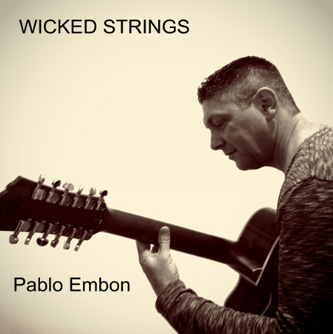 mwe3:
“Song Of India” has a mystical element to it. You mentioned
you were fascinated with the Raga and other Eastern musical styles.
Is there a modal kind of style on that track? I was sad that McCoy
Tyner recently passed away, especially as I noticed a kind of Tyner-esque
style on this special track.
mwe3:
“Song Of India” has a mystical element to it. You mentioned
you were fascinated with the Raga and other Eastern musical styles.
Is there a modal kind of style on that track? I was sad that McCoy
Tyner recently passed away, especially as I noticed a kind of Tyner-esque
style on this special track.
Pablo Embon: I consider Indian music to be one of the most
fascinating styles of ethnic music. It is extremely rich and brings
the listener to a totally unique arena. Western music can be perceived
as a simplification of several complex music styles involving ancient
music such as Indian. One of the key aspects of “Song Of India”
is that it was composed mostly around one minor chord only but using
a Bahiravi that, which brings all the richness of the scale associated
with it to the melody of the song, is performed on a Duduk, a 3000
year old Armenian wind instrument. The second section of the song
indeed uses some McCoyTyner fusion elements heard in the piano solo,
which are intended to blend into the mood, while creating a different
angle of the same concept.
mwe3: “Taste Of Freedom” is a very upbeat track that
moves at a very brisk pace. What inspired that track? I hear a kind
of Chick Corea sound on that track. Is there a cool story behind “Taste
Of Freedom”?
Pablo Embon: “Taste Of Freedom” is another example
of a fusion-sounding Latin jazz song. I was experimenting with different
rhythms and I also wanted to bring in a kind of Latin flavor to the
song, which can be heard on the nylon guitar solos. Playing nylon
guitar brought me back to my early guitar studies with Maestro Eduardo
Isaac back in the early 1980s, with whom I had the privilege of learning
the instrument.
mwe3:
Tell us about “My Little Magic Box”. Is there an electric
piano sound on that track? It’s a magical little track and I
like the way the piano interacts with the synth keyboards.
Pablo Embon: “My Little Magic Box: was performed on a
custom piano instrument called an 'Una Corda'. This custom piano has
one string per key across the whole keyboard and a design which brings
a very unique sound due to the resonance of the instrument. The background
of the song uses a hybrid electric piano. The second lead instrument
in the track is an acoustic guitar, which I believe blends well with
the Una Corda solo and gives a taste of a rock-like touch.
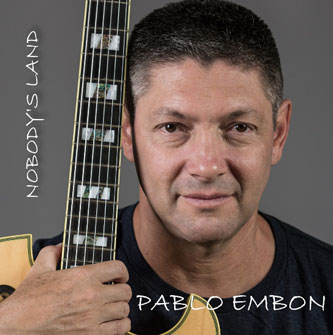 mwe3:
“The Voice Of Truth” has a very cool synth sound on it.
You mentioned last year that you were planning to use unique keyboards
like the Una Corda and the Harmochord on this album. Is there an unusual
sounding keyboard sound on “The Voice Of Truth” and what
other sounds and styles would you say enhanced that track?
mwe3:
“The Voice Of Truth” has a very cool synth sound on it.
You mentioned last year that you were planning to use unique keyboards
like the Una Corda and the Harmochord on this album. Is there an unusual
sounding keyboard sound on “The Voice Of Truth” and what
other sounds and styles would you say enhanced that track?
Pablo Embon: “The Voice Of Truth” features solos
on the Harmochord, a keyboard instrument, popular in the 1950s. The
intro riff is played on a hybrid version of the Yamaha CP80 electric
piano and a sitar is featured on the chorus and a transverse flute
in the bridge. Then a nylon guitar takes over the solo in the second
part of the song. This is how the focus is being shifted from one
instrument to the other one while attempting to keep the song's identity
intact.
mwe3: “Too Far, Too Close” is primarily a piano-based
track. Is there a story behind that track? There’s a lot of different
influences on “Too Far, Too Close”.
Pablo
Embon: This track talks about people you love who are far away
but very close to your heart. I’m frankly not very aware as to
what artists I would be influenced by. It may take me a lot of time
to identify some influences but it is not something that concerns
me most when I compose. I simply let my mind wander around an idea
once I have a purpose for a piece of music.
mwe3:
“Midnight Lullaby” has a kind of soundtrack sound to it.
Did you set out to write a very peaceful sounding track? Do you prefer
the low-key sound and style of “Midnight Lullaby” to the
more straight ahead sounding fusion styles?
Pablo Embon: I think, like everything else in life, it’s
about balance in music. I personally need those “Midnight Lullaby”
moments to stop running and contemplate more. This type of music comes
from very deep in me as a prerequisite for me to start looking at
upbeat music to play. Some sort of self-therapy if you will.
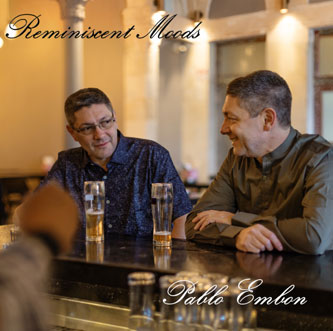 mwe3:
“Our Time” is one of my favorites on the Harmony Tales
album. Would you consider that track as a single to send to radio
for airplay? What inspired “Our Time” and what keyboards
are on that track? Sounds like a Hammond organ.
mwe3:
“Our Time” is one of my favorites on the Harmony Tales
album. Would you consider that track as a single to send to radio
for airplay? What inspired “Our Time” and what keyboards
are on that track? Sounds like a Hammond organ.
Pablo
Embon: Smooth Jazz Radio Global has proposed to me to spin this
track, as they see it as a very attractive song, having a funk element,
which seems to fit well with the music they play. When I learned to
play funk music back in the early 2000's, I had lot of fun. It was
like discovering all those cool things you would hear on the radio
such as Stevie Wonder and others. It is indeed a type of music that
grabs a lot of attention and, in my mind it’s a very cool genre
in jazz music with lots of opportunity to improvise freely.
mwe3:
When does “The Best Of Me” come from? You add 2019 to the
title. Is that the only solo piano track you’ve done in recent
times? What piano are you featuring on that track and why did you
title it “The Best Of Me”?
Pablo
Embon: The original version of “The Best of Me” was
included in my 2009 album Back To Source. It’s a solo
piano song with lots of movement and hand interaction, which I like
very much to play. I decided to take this track to a different place
by adding an improvisation section and completely remastering it.
I also recorded it this time performing on a Yamaha C7 Custom Concert
Piano, which sounds amazing and suits the needs of the track.
mwe3: What other plans do you have for the coming year?
Pablo Embon: As for 2020, this year became a great challenge
for all of us, but I believe that music and all forms of art have
been always there for people to ease up on their lives and open their
hearts. For me also,  it's
an opportunity to look at things from a different perspective and
most chances are that my upcoming music will certainly reflect this.
Now, it is also the time to give big thanks to so many people supporting
my music and my music career, by making a promise to myself and keep
striving to offer meaningful music to listen to every time...
it's
an opportunity to look at things from a different perspective and
most chances are that my upcoming music will certainly reflect this.
Now, it is also the time to give big thanks to so many people supporting
my music and my music career, by making a promise to myself and keep
striving to offer meaningful music to listen to every time...



